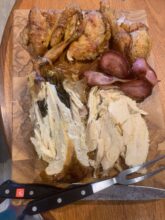BUTTER AND BACON ROAST CHICKEN
At home in Yorkshire, my mother always backed up her roast chicken with bacon – quite literally. She would brush the bird all over with melted butter and then drape the breast with slices of streaky bacon. I like to add a generous bunch of an aromatic fresh herb such as rosemary or thyme, a double whammy that wonderfully concentrates the flavours of the bird. Both herbs grow year round on my balcony. It is traditional in England to cut out the wishbone after the chicken is cooked, then the oldest and youngest at the table crack the bone with their little fingers; whoever secures the largest section has first choice of meat when the bird is carved.
Serves 4-6
A 2 kg/4-4 ½-lb chicken
Medium bunch of rosemary or thyme
4 tablespoons/60 g butter, at room temperature
Salt and pepper
4-5 slices/150g/5 oz streaky bacon
For gravy
2 cups/500 ml chicken stock
2 tablespoons flour
2 metal or wooden skewers
1. Heat the oven to 220ºC/425ºF and set a shelf low down. Wipe the chicken inside and out with damp paper towel. Cut out and discard the wishbone to make carving easier. (If you want to play at cracking the wishbone, roast it in the oven beside the chicken.) Tuck the wing pin bones under the chicken, set the bird breast upwards on the counter and secure the wings in place with a skewer. Bend the leg bones backwards towards the wings and secure them also in place with a skewer. Tuck the rosemary or thyme inside the chicken.
2. Spread the softened butter all over the bird, sprinkle with salt and pepper and set it in a roasting pan, breast upwards. Roast the chicken in the oven until it starts to brown, 20-25 minutes. Turn it upside down and continue roasting until the back is brown, another 20-25 minutes. Finally turn the bird breast upwards and drape the bacon on top.
3. Continue roasting until the bacon is brown, 15-20 minutes longer, then remove and set it aside. Baste the chicken with a few spoonfuls of stock. Continue roasting, basting often, until the chicken is thoroughly cooked and browned, 10-20 minutes longer depending on its size. The bird is done when the legs do not fight back when you wiggle them with your fingers. When the bacon is crisp, after 10-15 minutes, transfer it to a serving dish and set it in a warm place.
4. Test the bird to see if it is done. Best test is to lift it on a two-pronged fork and let juices run from the cavity. They should run clear. If pink, continue cooking until the juices are clear. Transfer the bird to a serving dish or board for carving, cover it loosely with foil and let stand 10-15 minutes so the juices are reabsorbed. Meanwhile make the gravy.
5. Set the roasting pan on top of the stove and stir in the flour. Whisk in the remaining stock. Heat the pan, whisking constantly to dissolve the browned pan juices, the juices should brown and thicken slightly when the gravy starts to bubble. Taste, adding salt and pepper if needed, and strain the gravy into a serving boat.
6. Carve the chicken in the kitchen and arrange it on a platter with the bacon on top; alternatively carve it at the table. Serve the gravy separately.
BRICK CHICKEN
One of the many specialty items of equipment that have accompanied Grandma in her travels from the US to France and now to the UK, is a standard building brick, the key to wonderfully dark, crispy roast chicken.
Heat the oven to 200ºC/400ºF and set a shelf low down. Wrap a building brick in foil. Using kitchen scissors, cut and discard the backbone from a medium chicken, set it cut side down on a chopping board and crack the breastbone flat with the palms of your hands. Cream ½ cup/110g butter and beat in 2 chopped cloves garlic, 1 chopped shallot and 2 tablespoons chopped parsley with salt and pepper. Slide your fingers under the chicken skin and spread the soft butter on the chicken breast and leg meat so the butter melts under the skin during cooking. Fasten the chicken flat using two wooden or metal skewers. The leg and wing bones should face towards the breastbone.
Put the chicken, breast side down, in a large skillet or frying pan, cover it with a sheet of foil and weigh it down with the foil-wrapped brick on top. Heat the skillet on the stovetop until very hot, then transfer it to the heated oven. Bake the chicken in the oven for 30 minutes, loosening it from the surface of the skillet once or twice. When the skin side of the chicken is brown and crisp, turn over the bird, replace the brick on top and continue cooking 30-40 minutes longer. The skin side of the chicken should be very brown, and the meat should be tender enough for the legs to feel loose when pulled.
Discard the skewers and serve the bird browned side upwards. It can be carved on a platter at table or cut in pieces in the kitchen. Decorate the platter with sprigs of watercress or fresh salad greens. Small boiled new potatoes, or potatoes roasted in the oven around the chicken, are the best accompaniment. A medium chicken will serve 4-6.

